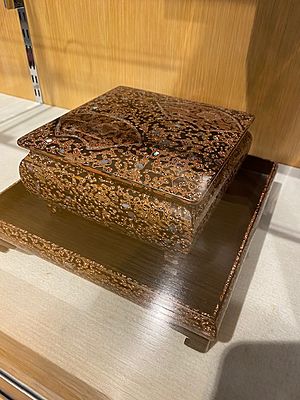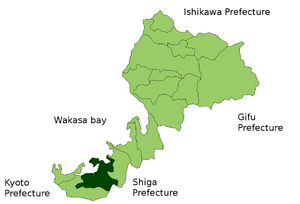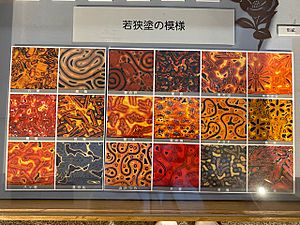Wakasa Lacquerware facts for kids
Wakasa lacquerware (若狭塗, Wakasa-nuri) is a special type of traditional craft from Obama City in Fukui Prefecture, Japan. It's known for its beautiful patterns. These designs often use tiny pieces of eggshells, seashells, and even pine needles.
One unique method used is called togidashi maki-e. This technique creates big, detailed patterns. Artisans apply many layers of lacquer, which is a type of natural varnish. This process takes a long time and is done carefully, step by step. Each piece of Wakasa lacquerware is made by just one artisan from start to finish.
Wakasa lacquerware is especially famous for its chopsticks in Japan. Obama City makes 80% of all lacquer chopsticks in the country. However, most of these are made in factories. Less than 1% of the chopsticks from Obama City are actually made by skilled artisans. These handmade chopsticks are very special. It takes an artisan at least six months to create just one pair! In 2008 and 2013, Obama City even gave a lacquer picture frame and a lacquer pen to Barack Obama, who was the President of the United States at the time.
History of Wakasa Lacquerware
Wakasa lacquerware began a long time ago, around the early Edo period (1596 to 1615). An artisan named Sanjuro Matsuura created the first pieces. He designed patterns that looked like the seabed of Wakasa Bay. He got ideas from Chinese lacquerware to develop his techniques.
Later, during the Manji era (1658 to 1660), these techniques got even better. The local lords and their families supported the artisans. This helped Wakasa lacquerware become a very important industry for the Obama area.
The best time for Wakasa lacquerware was from the middle to late Edo period (1603-1868). It was very popular and sold a lot. But over time, fewer people wanted it. Today, artisans are trying new ideas. They are making modern items like computer mice and accessories. However, the number of artisans is getting smaller. As of 2020, there were only four Wakasa lacquerware artisans left.
How Wakasa Lacquerware is Made
Making Wakasa lacquerware involves 11 careful steps. Each step helps create the beautiful and strong finished product.
- Cloth Covering: First, a piece of cloth or special Japanese paper is glued onto the wood. This protects the wood and covers any small holes.
- Base Coating: Next, a smooth layer is put on. This layer is made from raw lacquer mixed with jinoko, which is a powder from baked clay. After that, another coat of lacquer mixed with tonoko (rock powder) is added.
- Second Coating: A layer of lacquer is applied to stop the tonoko from soaking up the paint for the patterns.
- Pattern Painting: This is where the designs come to life! Artisans use natural materials like eggshells, seashells, or pine needles to create unique patterns. This step is usually done from December to March. This is the best time for the lacquer to dry properly.
- Combination Painting 1: Two or more colors of lacquer are painted over the piece. This creates the special colors and shine that Wakasa lacquerware is known for.
- Combination Painting 2: Another layer of combined colors is added. The piece must be completely dry before this step.
- Gliding: After the combination painting is done, thin sheets of gold leaf are carefully placed onto the surface.
- Overpainting: This technique makes the product stronger. Artisans also shave off layers to create many different patterns.
- Grind Stone Polishing: This step is very unique to Wakasa lacquerware. The piece is polished using rough, medium, and fine grindstones. This brings out the patterns hidden underneath the layers. Other types of lacquerware do not use this process.
- Coal Polishing: More special lacquers are added for extra effects. Then, the surface is carefully polished using rough and smooth coals made from trees. This makes the surface very smooth.
- Finish Polishing: Finally, the piece is rubbed with a cloth mixed with tonoko and rapeseed oil. Then, it's polished with cotton and raw lacquer. The very last touch is polishing the product with a finger and the palm of the hand.
Related Websites
- KOGEI JAPAN wakasanuri
- 若狭御食国おばま食文化館 若狭御食国おばま食文化館




